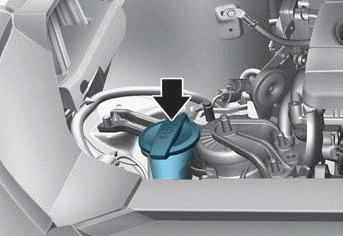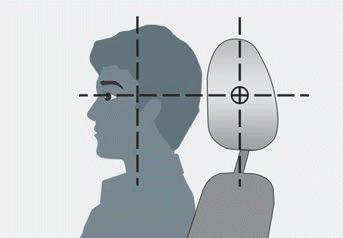Hyundai Venue: Maintenance / Washer Fluid
Checking the Washer Fluid Level

Check the fluid level in the washer fluid reservoir and add fluid if necessary. Plain water may be used if washer fluid is not available. However, use washer solvent with antifreeze characteristics in cold climates to prevent freezing.
WARNING
To prevent serious injury or death, take the following safety precautions when using washer fluid:
- Do not use engine coolant or antifreeze in the washer fluid reservoir. Engine coolant can severely obscure visibility when sprayed on the windshield and may cause loss of vehicle control resulting in an accident or damage to paint and body trim.
- Do not allow sparks or flames to contact the washer fluid or the washer fluid reservoir. Washer fluid may contain alcohol and can be flammable.
- Do not drink washer fluid and avoid contact with skin. Washer fluid is harmful to humans and animals.
- Keep washer fluid away from children and animals.
 Brake/Clutch Fluid
Brake/Clutch Fluid
Checking the Brake/Clutch Fluid Level
Check the fluid level in the reservoir periodically. The fluid level should be
between MAX and MIN marks on the side of the reservoir...
 Parking Brake
Parking Brake
Checking the Parking Brake
Check the stroke of the parking brake by counting the number of “clicks” heard
while fully applying it from the released position...
Other information:
Hyundai Venue (QX) (2020-2025) Owners Manual: Tire Terminology and Definitions
Air Pressure The amount of air inside the tire pressing outward on the tire. Air pressure is expressed in pounds per square inch (psi) or kilopascal (kPa). Accessory Weight This means the combined weight of optional accessories. Some examples of optional accessories are automatic transmission, power seats, and air conditioning...
Hyundai Venue (QX) (2020-2025) Service Manual: Air Cleaner. Repair procedures
Removal and Installation 1. Remove the engine cover. (Refer to Engine and Transaxle Assembly - "Engine Cover") 2. Disconnect the battery negative terminal. 3...
Categories
- Manuals Home
- 1st Generation Venue Owners Manual
- 1st Generation Venue Service Manual
- Trip Computer
- Shift-lock system, Shift-lock release, Parking
- Type B, C
- New on site
- Most important about car
Head Restraints
The vehicle’s front and rear seats have adjustable head restraints. The head restraints provide comfort for passengers, but more importantly they are designed to help protect passengers from whiplash and other neck and spinal injuries during an accident, especially in a rear impact collision.
WARNING
To reduce the risk of serious injury or death in an accident, take the following precautions when adjusting your head restraints:
Always properly adjust the head restraints for all passengers BEFORE starting the vehicle. NEVER let anyone ride in a seat with the head restraints removed or reversed.
